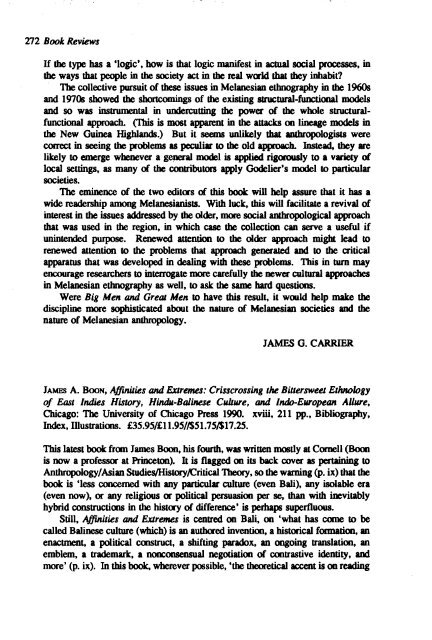1991 No. 1 CONTENTS - Institute of Social and Cultural ...
1991 No. 1 CONTENTS - Institute of Social and Cultural ...
1991 No. 1 CONTENTS - Institute of Social and Cultural ...
You also want an ePaper? Increase the reach of your titles
YUMPU automatically turns print PDFs into web optimized ePapers that Google loves.
272 Book Reviews<br />
H the type has a 'logic', how is that logic manifest in actual social processes, in<br />
the ways that people in the society act in the real wmld that they inhabit?<br />
The collective pursuit <strong>of</strong> these issues in Melanesian ethnography in the 1960s<br />
<strong>and</strong> 19708 showed the shortcomings <strong>of</strong> the existing structural-functional models<br />
<strong>and</strong> so was insttumental in undercutting the power <strong>of</strong> the whole sttucturalfunctional<br />
approach. (This is most apparent in the attacks on lineage models in<br />
the New Guinea Highl<strong>and</strong>s.) But it seems unlikely that anthropologists were<br />
correct in seeing the problems as peculiar to the old approach. Instead, they are<br />
likely to emerge wbeDever a ge~al model is applied rigorously to a variety <strong>of</strong><br />
local settings, as many <strong>of</strong> the contributors apply Godelier's model to particular<br />
societies.<br />
The eminence <strong>of</strong> the two editCl'S <strong>of</strong> this book will help assure that it has a<br />
wide readersbip among Melanesianists. With luck, this will facilitate a revival <strong>of</strong><br />
interest in the issues addressed by the older, more social aotbropological approach<br />
that was used in the region, in wbich case the collection can serve a useful . if<br />
unintended purpose. Renewed attention to the older approach might lead to<br />
renewed attention to the problems that approach generated <strong>and</strong> to the aitical<br />
apparatus that was developed in dealing with these problems. This in turn may<br />
encourage researchers to interrogate more carefully the newer cultural approaches<br />
in Melanesian ethnography as well, to ask the same hard questions.<br />
Were Big Men <strong>and</strong> Great Men to have this result, it would help make the<br />
discipline more sophisticated about the nature <strong>of</strong> Melanesian societies <strong>and</strong> the<br />
nature <strong>of</strong> Melanesian anthropology.<br />
JAMES O. CARRIER<br />
JAMES A. BooN, Affinities <strong>and</strong> Extremes: Crisscrossing the BiUersweet Ethnology<br />
0/ East Indies History, Hindu.-BaliJwe Culture, <strong>and</strong> Indo-European Allwe,<br />
Chicago: 1be University <strong>of</strong> Chicago Press 1990. xviii, 211 pp., Bibliography,<br />
Index,Illustratioos. £35.95/£11.95/1$51.751$17.25.<br />
This latest book: frem James Boon, his fourth, was written mostly at Comell (Booo<br />
is now a pr<strong>of</strong>essor at Princeton). It is flagged on its back cover as pertaining to<br />
Anthropology/Asian Studies/History/Critical Theory, so the warning (p. ix) that the<br />
book is 'less concerned with any particular culture (even Bali), any isolable era<br />
(even now), or any religious or political persuasion per se, than with inevitably<br />
hybrid consttuctioos in the histmy <strong>of</strong> difference' is perhaps superfluous.<br />
Still, Affinities <strong>and</strong> Extremes is centred· on BaIi, on 'what has come to be<br />
called Balinese culture (which) is an authCl'ed invention, a historical formation, an<br />
enactment, a political coosttuct, a shifting paradox, an ongoing translation, an<br />
emblem, a trademark, a nooconsensual negotiation <strong>of</strong> contrastive identity, <strong>and</strong><br />
more' (p. ix). In this book, wherever possible, 'the theoretical accent is on reading
















